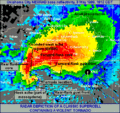Tornado
Tornado[edit]
A tornado is a rapidly rotating column of air that is in contact with both the surface of the Earth and a cumulonimbus cloud or, in rare cases, the base of a cumulus cloud. The wind speeds of tornadoes can reach up to 300 miles per hour (480 km/h), and they can cause significant damage to structures and vegetation in their path.
Formation[edit]
Tornadoes form in association with severe thunderstorms, particularly those known as supercells. A supercell is a thunderstorm with a deep, persistently rotating updraft called a mesocyclone. The process of tornado formation is complex and involves the interaction of various atmospheric conditions, including wind shear, instability, and moisture.
Mesocyclone[edit]
A mesocyclone is a region of rotation within a thunderstorm. It is typically 2 to 10 kilometers in diameter and is associated with the development of severe weather, including tornadoes. The rotation of the mesocyclone is often visible as a wall cloud, which is a lowering of the cloud base.
Tornadogenesis[edit]
The process of tornado formation, or tornadogenesis, involves the intensification of the mesocyclone and the development of a funnel cloud. As the funnel cloud descends, it may reach the ground and become a tornado. The exact mechanisms of tornadogenesis are still a subject of research.
Classification[edit]
Tornadoes are classified based on the Enhanced Fujita (EF) scale, which estimates wind speeds based on the damage caused. The scale ranges from EF0, with minor damage, to EF5, with incredible damage.
Tornado Alley[edit]
Tornado Alley is a colloquial term for a region of the United States where tornadoes are most frequent. This area includes parts of Texas, Oklahoma, Kansas, Nebraska, and South Dakota. The region's unique geography and climate contribute to the high frequency of tornadoes.
Safety and Preparedness[edit]
To protect against tornadoes, it is important to have a safety plan in place. This includes identifying a safe location, such as a basement or interior room, and having an emergency kit ready. Tornado warnings and watches are issued by meteorological agencies to alert the public of potential tornado threats.
Related Pages[edit]
Gallery[edit]
-
F5 tornado in Elie, Manitoba, 2007
-
Tornado near Anadarko, Oklahoma, 1999
-
Tornado in Waurika, Oklahoma
-
Diagram of tornado infrasound sources
-
Time-lapse of a tornado
-
Formation of a wall cloud from a mesocyclone
-
Stovepipe tornado near Yuma, Colorado
-
Tornado roping out in Eastern Colorado
-
Trombe
-
Dust devil
-
Aerial view of tornado damage in Moore, Oklahoma, 2013
-
Global distribution of tornadoes
-
Map of Tornado Alley
-
Annual tornado count in the US
-
Historical tornado illustration, 1857
-
Radar graphic of a tornado near Naperville and Woodridge
-
Wall cloud
-
Tornadoes in Pilger, Nebraska
-
Damage from the Birmingham tornado, 2005
-
Tornado with Doppler on Wheels
-
Rope tornado near Yuma, Colorado
-
Tornado near Punkin Center, Colorado
-
EF0 tornado over the North Sea
-
Tornado roping out near Merino, Colorado
-
Andover tornado, April 29, 2022
-
Radar of a classic supercell
-
NEXRAD radar of an EF2 tornado in Kansas
-
Doppler on Wheels radar image
<references group="" responsive="1"></references>
Ad. Transform your life with W8MD's Budget GLP-1 injections from $75


W8MD offers a medical weight loss program to lose weight in Philadelphia. Our physician-supervised medical weight loss provides:
- Weight loss injections in NYC (generic and brand names):
- Zepbound / Mounjaro, Wegovy / Ozempic, Saxenda
- Most insurances accepted or discounted self-pay rates. We will obtain insurance prior authorizations if needed.
- Generic GLP1 weight loss injections from $75 for the starting dose.
- Also offer prescription weight loss medications including Phentermine, Qsymia, Diethylpropion, Contrave etc.
NYC weight loss doctor appointmentsNYC weight loss doctor appointments
Start your NYC weight loss journey today at our NYC medical weight loss and Philadelphia medical weight loss clinics.
- Call 718-946-5500 to lose weight in NYC or for medical weight loss in Philadelphia 215-676-2334.
- Tags:NYC medical weight loss, Philadelphia lose weight Zepbound NYC, Budget GLP1 weight loss injections, Wegovy Philadelphia, Wegovy NYC, Philadelphia medical weight loss, Brookly weight loss and Wegovy NYC
|
WikiMD's Wellness Encyclopedia |
| Let Food Be Thy Medicine Medicine Thy Food - Hippocrates |
Medical Disclaimer: WikiMD is not a substitute for professional medical advice. The information on WikiMD is provided as an information resource only, may be incorrect, outdated or misleading, and is not to be used or relied on for any diagnostic or treatment purposes. Please consult your health care provider before making any healthcare decisions or for guidance about a specific medical condition. WikiMD expressly disclaims responsibility, and shall have no liability, for any damages, loss, injury, or liability whatsoever suffered as a result of your reliance on the information contained in this site. By visiting this site you agree to the foregoing terms and conditions, which may from time to time be changed or supplemented by WikiMD. If you do not agree to the foregoing terms and conditions, you should not enter or use this site. See full disclaimer.
Credits:Most images are courtesy of Wikimedia commons, and templates, categories Wikipedia, licensed under CC BY SA or similar.
Translate this page: - East Asian
中文,
日本,
한국어,
South Asian
हिन्दी,
தமிழ்,
తెలుగు,
Urdu,
ಕನ್ನಡ,
Southeast Asian
Indonesian,
Vietnamese,
Thai,
မြန်မာဘာသာ,
বাংলা
European
español,
Deutsch,
français,
Greek,
português do Brasil,
polski,
română,
русский,
Nederlands,
norsk,
svenska,
suomi,
Italian
Middle Eastern & African
عربى,
Turkish,
Persian,
Hebrew,
Afrikaans,
isiZulu,
Kiswahili,
Other
Bulgarian,
Hungarian,
Czech,
Swedish,
മലയാളം,
मराठी,
ਪੰਜਾਬੀ,
ગુજરાતી,
Portuguese,
Ukrainian

























